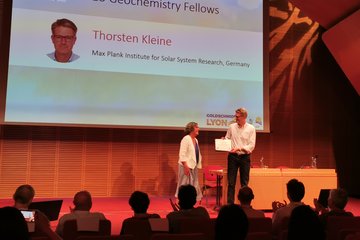Alle Typen
141.
Zeitschriftenartikel
SLiM: a code for the simulation of wave propagation through an inhomogeneous, magnetised solar atmosphere. Astron. Nachrichten 328, S. 313 - 318 (2007)
142.
Zeitschriftenartikel
Solar Cycle Prediction Using Precursors and Flux Transport Models. Astrophysical Journal 659, S. 801 - 811 (2007)
143.
Zeitschriftenartikel
Radiative MHD simulations of solar pores. Astronomy and Astrophysics 474, S. 261 - 272 (2007)
144.
Zeitschriftenartikel
Saturation properties of the Archontis dynamo. Mon. Not. Roy. Astron. Soc. 365, S. 735 - 746 (2006)
145.
Zeitschriftenartikel
High field strength modified ABC and rotor dynamos. Mon. Not. Roy. Astron. Soc. 367, S. 1163 - 1169 (2006)
146.
Zeitschriftenartikel
The structure of small-scale magnetic flux tubes. Mon. Not. Roy. Astron. Soc. 358, S. 1025 - 1035 (2005)
147.
Zeitschriftenartikel
The Sun - a ball of electrically well-conducting gas. inSIDE - Innovatives Supercomputing 2 (1), S. 4 - 5 (2004)
148.
Zeitschriftenartikel
Distribution of Faraday rotation measure in jets from active galactic nuclei. I. Predictions from our sweeping magnetic twist model. Astrophysical Journal 600 (1), S. 88 - 95 (2004)
149.
Zeitschriftenartikel
Distribution of Faraday rotation measure in jets from Active Galactic Nuclei. II. Prediction from our sweeping magnetic twist model for the wiggled parts of active galactic nucleus jets and tails. Astrophysical Journal 608, S. 119 - 135 (2004)
150.
Buchkapitel
Simulation of solar magneto-convection. In: High Performance Computing in Science and Engineering: Transactions of the Second Joint HLRB and KONWIHR Result and Reviewing Workshop, S. 431 - 442 (Hg. Wagner, S.; Hanke, W.; Bode, A.; Durst, F.). Springer, Berlin (2004)
151.
Konferenzbeitrag
Semi-empirical Long-term Reconstruction of the Heliospheric Parameters: Validation by Cosmogenic Radionuclide Records. Publications of the astronomical society of the pacific 504, S. 269 - 272 (2016)
152.
Konferenzbeitrag
The Solar cycle: looking forward. In: Highlights of Astronomy, H16, S. 111 - 112. ANY PUBLISHER, Cambridge University Press (2015)
153.
Konferenzbeitrag
Convectively stabilised background solar models for local helioseismology. In: Proceedings of the HELAS Workshop NA3-4, ``The Acoustic Solar Cycle'', University of Birmingham, 6-8 January 2009 (Hg. Elsworth, Y. P.; Thompson, M. J.). The University of Sheffield (2010)
154.
Konferenzbeitrag
Expansion of Magnetic Flux Concentrations with Height: A Comparison of Hinode SOT Data and MHD Simulations. In: The Second Hinode Science Meeting: Beyond Discovery - Torward Understanding, 91 (Hg. Lites, B.; Cheung, M.; Magara, T.; Mariska, J.; Reeves, K.). (2009)
155.
Konferenzbeitrag
Numerical Simulations of Quiet Sun Oscillations. ASP Conference Series, S. 49 - 54 (2009)
156.
Konferenzbeitrag
Photospheric magnetoconvection. In: Convection in Astrophysics, S. 488 - 493 (Hg. Kupka, F.; Roxburgh, I.; Chan, K.). Cambridge University Press (2007)
157.
Konferenzbeitrag
Helioseismology at MPS. In: Modern Solar Facilities - Advanced Solar Science, S. 89 - 102 (Hg. Kneer, F.; Puschmann, K. G.; Wittmann, A. D.). Universitätsverlag Göttingen, Göttingen, Germany (2007)
158.
Konferenzbeitrag
Three-dimensional numerical simulation of wave propagation through a model sunspot. In: Proceedings of SOHO 18 / GONG 2006 / HELAS I - Beyond the spherical Sun, 7-11 August 2006, Sheffield, UK (Hg. Fletcher, K.). ESA Publ. Div., Noordwijk, The Netherlands (2006)
159.
Konferenzbeitrag
Simulations of solar pores. In: Proceedings of the 11th European Solar Physics Meeting - The Dynamic Sun: Challenges for Theory and Observations, 11-16 September 2005 (Hg. Danesy, D.; Poedts, S.; De Groof, A.; Andries, J.). ESA Publ. Div., Noordwijk (2005)
160.
Konferenzbeitrag
The Decay of a Simulated Pore. In: The Solar-B Mission and the Forefront of Solar Physics, S. 57 - 62 (Hg. Sakurai, T.; Sekii, T.). (2004)











